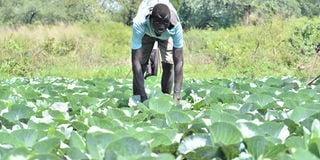Prime
Grow cabbages and get rich

A farmer tends to his cabbage garden. PHOTO/George Katongole
What you need to know:
Soil for growing cabbages should be ploughed to break up all lumps of soil. If it needs to be supplemented, well-rotted manure should be mixed. Usually, farmers are advised to add an NPK-based fertiliser at planting.
Cabbage has been a part of the human culinary story because of its high concentration of Vitamin C often used for medical purposes. Cabbage is crunchy when eaten raw, especially in salads.
Proponents of cabbage growing explain that cabbage has a ready market on both a small and large scale.
Nicholas Sunday, a community-based facilitator who oversees the production of cabbages in refugee communities in Bidibidi Refugee Settlement in Yumbe under the Adventist Development and Relief Agency (ADRA) explains that cabbages can be a cash cow if taken seriously.
“The mathematics is simple. In a quarter of an acre, about 2000 plants can be planted. If each is sold for about Shs1, 500 to2,000 a farmer can earn a minimum of Shs3m in each harvest,” Sunday says.
He stresses that all this happens in just a short time. Cabbage will be ready for harvest in 80 to 180 days from seed depending on the variety or in 60 to 105 days from transplanting.
Site selection
Cabbage is mainly rain fed in Uganda. Cabbage is a heavy feeder which thrives in well drained fertile sandy loam soils. The preferred soils should be rich in organic matter and must exhibit high water holding capacity.
In choosing the best site, he explains that one must look for a site in which a crop from the cabbage family such as kale and spinach had not been previously grown because they share the same pests and diseases.
Land preparation
Soil for growing cabbages should be ploughed to break up all lumps of soil. If it needs to be supplemented, well-rotted manure should be mixed. Usually, farmers are advised to add an NPK-based fertiliser at planting.
Sunday stresses that soil sterilisation is becoming an important aspect in nursery-bed management. In cabbage growing, he says this is done by burning grass and waiting for it to cool down after about two days.
Nursery bed management
There are a number of cabbage varieties grown in Uganda including; Copenhagen, Gloria F1, Escazu, Sugarloaf, Giant Drum Head, Prize Drum Head and Red Cabbage.
According to Sunday, one should consider the head size, weight, yield potential, pest and disease tolerance and market while choosing a variety to plant.
The main priority should be on buying certified seeds because they give high yields of good quality, minimise the likelihood of crop failure, are resistant to some pests and diseases yet they grow fast, strongly and uniformly.
Seeds are propagated by using the seed tray method or nursery bed.
In both techniques, song should be done in well controlled and protected nursery with soils prepared into sine tilth. Sowing lines 10cm and 2-3cm deep should be made.
The seedbed can be covered by use of dry grass or gunny bags and water gently to avoid splashes.
Seeds are expected to germinate after three days. At that time, the cover is removed. He encourages farmers to ensure frequent watering early in the morning.
But in the nursery, one should watch out from soil borne pests and diseases, damping off and infestation of cutworms after transplanting.
After 10 days, the farmer is encouraged to spray for leaf spots and powdery mildew. Subsequently, protection is offered against aphids, whiteflies, leaf spots and powdery mildew.
After 21 days, Sunday explains that one should start hardening off. in order to help them transition successfully. Hardening off exposes newly grown vegetables to the hanging temperatures, varying levels of sunlight, wind—to enable healthy growth.
Agronomy
Sunday explains that seedlings must be transplanted when they are 10-15cm or when they have developed 5-6 leaves.
As a general rule, the bed must be watered the previous day before transplanting in the evening to minimise shock.
Although spacing varies, the recommended spacing is 60x60cm.
In case of large scale farming, composted farmyard manure of about 8-10 metric tonnes per acre is applied. Basal fertilisers rich in phosphorus on the planting hole can be applied.
In case of adverse weather, he adds, irrigation is an option. Sunday stresses that cabbage has a shallow root system and hence requires frequent light irrigations especially during head formation. He says this should be done early or mid-morning.
A farmer should also use ridges to allow monitoring and avoid water logging.
Pest and disease control
Cabbage is affected by a wide variety of diseases including; Cabbage worms which ravage the underside of leaves leaving ragged holes, Cutworms, Root Maggots, beetles, aphids and damping off, which leads to wilting and death of seedlings. Other notable diseases are black rot, leaf spot and moths.
According to Sunday, these are controlled by application of insecticides and fungicides.
“But there are seed varieties that are disease-resistant which farmers can look out for,” he says.
Crop rotation is another effective control method.
Another effective way is to remove aging leaves from the base.
Hardening off
Withhold water for a few days before moving the plants outdoors.
Move the plants outdoors for a few hours, placing them in a sheltered spot protected from wind and direct sun.
Gradually increase the length of time outdoors and amount of exposure until the plants are outdoors 8 to 12 hours at a time.




